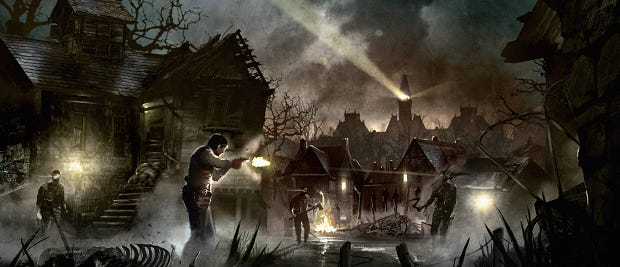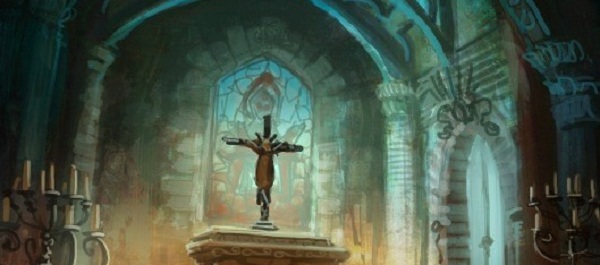Horror Stories: A Maddening Lack Of Imagination
Bane Of Terror
Looking through the recent releases on Steam, a casual observer might believe that there’s a horror game renaissance underway. In the last few weeks, several games have appeared, with titles like Paranormal and The Orphanage. I’ve installed a few of them, heard them go bump in the night, and then moved on. Despite some quality releases, horror is in a rut. And it’s an unpleasant one.
Earlier today, I had a peculiar reaction to the footage of The Evil Within that oozed through the clogged pipes of the interweb from the Eurogamer Expo and directly onto my screen. As Craig pointed out, the spinny-blade room is so daft that it’s immediately rendered non-threatening. Finding such a machine in a mental institution raises logistical questions rather than the hairs on the back of my neck.
Oh, that’s the other thing. The spinny-blade deathtrap is in a mental institution. Of course it is. Mental institutions are full of things like that. Frightening, horrible unnatural things. There’s nothing more horrid than the people who are actually inside the institutions though. They’re the most terrifying things imaginable, whether they’re doctors carrying out sadistic experiments, or inmates with dangerous tendencies and animalistic qualities, or even the bureaucrats preserving the outward appearance of healing while actually taking funds from the army to create a new breed of super soldiers.
In games, people with mental illnesses are often monsters or victims, sometimes both, and they are intended to inspire feelings of disgust, fear and repulsion. These associations aren’t unique to gaming, of course, like many trappings of genre cul-de-sacs, they have long been a part of all manner of horror fiction. More than that, the threatening and contagious otherness of the mad has, over time, taken the place of other fears, in a way that Foucault recognised.
“Once leprosy had gone, and the figure of the leper was no more than a distant memory, these structures still remained. The game of exclusion would be played again, often in these same places, in an oddly similar fashion two or three centuries later. The role of the leper was to be played by the poor and by the vagrant, by prisoners and by the 'alienated'.”
Yeah, I dropped some Madness and Civilization in there, but it’s not just my way of showing off how dry my bookshelves are, it’s also to show that when we see the scary crazy person in a game, or the darkened wards and rusted bedframes, we’re not looking at a new phenomenon. There is great sophistication in the best horror fiction, whether it deals with madness or not, and as I mentioned when I wrote my thoughts on A Machine For Pigs, the truly horrible stories usually involve introspection.
There’s a world of difference between Norman Bates’ defiant and yet sympathetic flirtatious confession - “we all go a little mad sometimes” – and the deranged bogeyman who will break down his cell door and eat you from the toes up to the chin because his madness (and his writer) demand nothing more of him. Unfortunate that Bates’ film and book are called Psycho, a true contraction of a complexity, but the character endures because we believe in him, as a man with a monstrous side rather than a monster that happens to resemble a man.
By compacting the mad into the monstrous, writers and designers fall back on clichés as tired as the term ‘tired clichés’. As soon as we enter the asylum, we have certain expectations. We’ve been there too many times and unless there’s an extraordinary – or perhaps ordinary (see Session 9) – alteration to the template, it’s difficult to surprise with anything other than loud noises, grotesque injuries and flickering lights. The Evil Within footage could be an excerpt from an alternate take on Outlast, with a gun instead of a camera and a dragging third-person limp instead of well-realised first-person body presence.
A man enters a creepy institution and everything about the place tells us that something is wrong. The darkness, the fact that it seems deserted, the physically impossible door hinges…it’s all wrong. There is nothing surprising, shocking or interesting about the scenario, particularly for those of us who did play Outlast a week or two ago, because as soon as we’re told there’s an asylum in a horror game, we expect the scenario to unfold exactly as it does here.
The spinning blades are no more nonsensical than the chainsaw wielding maniac. Neither belongs in a mental institution,but they do belong in a campy/creepy game environment. The fact that the place purports to be some kind of madhouse probably won’t matter very much to what little narrative there might be. It’s wallpaper to act as a backdrop for bludgeoning and butchery. It could as easily be a carnival full of insane clowns or an abandoned hotel full of insane bellboys, or an insurance office full of insane filing clerks.
When a place is so far removed from its real purpose, it loses meaning. The asylum as portrayed in Outlast is plucked directly from the horror genre. It no longer has a real world analogue, although the impressive fidelity of the graphics occasionally convinces otherwise by showing us objects and textures that we recognise, right down to the scuff marks and imperfections. The parts convey something sinister and familiar, but they’re soon splattered with too many strokes of false red and the whole picture becomes little more than another fairground funhouse.
A funhouse can be fun, but there can be elegance and intelligence in horror stories. A Machine for Pigs and Black Crown, which I’ve covered recently, both contain horrific elements but concern themselves with posing questions to the player and providing answers that evoke more than flinching flesh, causing thoughts to flinch as well, and connections to be made.
Much of Black Crown’s horror is, however, rooted in the flesh. Body horror of the Cronenberg school returns us to Foucault’s lepers, but now we have sympathy with the sick rather than shunning them, wanting to help but unable to act. It’s the terror of our own bodies collapsing, through impossible contaminations that are social, technological, psychic and hubristic. Contamination from a living source is not necessarily required and when it is, the act of transmission is not always aggressive.
Black Crown takes a different route. Sherman uses diseases and bodily aches to anchor the player. Pain and decay as the universal human experience, the thread that links us to Wonderland and allows us to gain some understanding of its inhabitants. No matter how far from home we are, the description of a stubbed toe or the uneasy pivot of a loose tooth can bring us back to our own bodies. It’s only when we’re there, hugging our skin tight around us, that we can really participate in the horror of it all. As long as we’re in somebody else’s shoes, fleeing from or fighting with alienated creatures that have less humanity than a desk drawer, every madhouse is a funhouse. Such places find few footholds in the imagination, even if they do scare us a little.
Great horror can use the threads of other pains, cutting into our emotional and mental confusions to remind us of the fragility of our understanding, and of the ways in which we are understood. Games can achieve this, of course, because images, sounds and words can, and games can be all of those things working together. But, at their best, games can implicate us in ways that traditionally observed media cannot and turn the screw an extra few degrees.
However, games can also fill their corridors and torture chambers with the mad, and make otherness and illness things to defeat or to hide from rather than to engage with. That’s much less imaginative, much less empathic and, most damning of all in a creative industry, much less interesting.
Now, go look at Asylum Jam.












